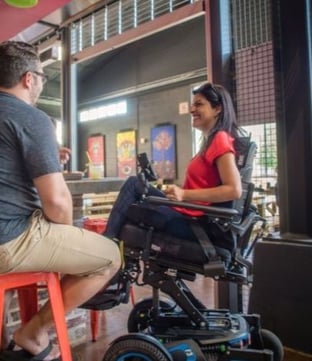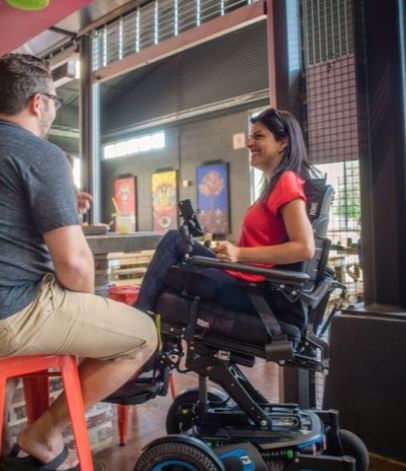Today we will look at the power seat function for elevation. When we talk about elevation, we are referring to the raising up of the seat pan. You may also hear elevation referred to as seat elevate, or lift. Elevation can be beneficial to the user for functional, psycho-social, and physical benefits.
Let’s start with the functional benefits. The first benefit is the improvement of or independence with transfers. Many people need to complete lateral transfers, where they slide across from their wheelchair to another surface such as the bed, toilet, or car. The difficulty with lateral transfers occurs when the user has to go from a lower surface to a higher surface. With seat elevate, most transfers out of the wheelchair can now be level or with a slight decline. The seat elevate can also be helpful with sit to stand transfers. Another great function benefit of elevation is the improvement of the user’s vertical reach. Often with sitting in a wheelchair, activities or tasks will become overhead. This means that the user has to be able to reach overhead to complete this task or activity. Seat elevation may allow the user to increase their independence by completing overhead activities, and this can also lead to additional physical benefits. Overhead reaching could increase the user’s risk of shoulder impingement or perhaps the user does not have the strength in their arms or trunk to complete this task or activity, and with seat elevate this will no longer be a problem. It’s not just about the shoulder. There is also a large impact on the neck, or cervical spine, with constantly performing overhead activities or looking up throughout the users’ day. Seat elevation can reduce the potential problems of overhead reaching.
Finally, let’s touch on the psycho-social benefits. In a previous blog, I discussed this topic of being able to come to eye level with your peers. This seat elevation allows the user to come to eye level with their peers, promoting the user to be part of the conversation. Seat elevation gives the user the power to choose at what height they want to be.

There are of course are a few limitations even when the user is able to elevate. Many times, I hear people talk about how with seat elevate they will be able to reach into all of the cabinets in their kitchen. Now, this could be true, but for many users they can now get up to open the cabinet, and reach the first few items, but they will have difficulty reach all the way into the cabinet. This is because the user is typically seated back and would have to lean forward in order to reach further into the cabinet. This is one example, but we can see that seat elevate while very beneficial for independence with some functional activities may not provide the solution for all tasks or activities. Last week we briefly discussed ActiveReach™ and its benefits with vertical reach. For those clients that are looking to get that further reach, have better access to their sink and kitchen, and to even further enhance their participation through active posture, ActiveReach™ that includes both elevation and anterior tilt might be the right choice.
Remember, not everyone will need seat elevate, but it is important to assess each individual and determine if the function is appropriate.

Rachel Fabiniak PT, DPT
Director of Clinical Services
Rachel Fabiniak began her studies at The Georgia Institute of Technology, where she graduated with her Bachelor of Science in Biology in 2009. Rachel then went on to receive her Doctorate in Physical Therapy from Emory University in 2013. After receiving her doctorate, Rachel went into clinical practice as a physiotherapist in the Spinal Cord Injury Day Program at Shepherd Center in Atlanta, Ga. Rachel also has experience in community physiotherapy and inpatient rehabilitation. During Rachel’s time at Shepherd Center, she developed a passion for seating and mobility which ultimately led to her career with Permobil. Rachel joined on with Permobil in January 2018 and relocated to Sydney, Australia in June 2018 as the clinical education specialist for Australia and New Zealand. In February 2020 Rachel moved into the role of Director of Clinical Services for Asia-Pacific.
